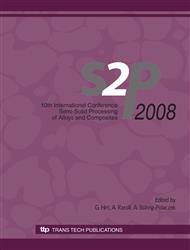p.373
p.379
p.385
p.391
p.397
p.403
p.409
p.415
p.421
Study of ECAP Processing Routes on Semi-Solid Microstructure Evolution of A356 Alloy
Abstract:
Semi- solid (SS) processing technologies provide the production of metal parts with homogeneous, fine and globular – grained microstructure. This is one of the most successful and reliable methods to produce near net shape products exhibiting good mechanical properties. Production of feed stock with non-dendritic and spherical structure is the critical factors in semisolid forming. Among several processes to obtain a globular microstructure, the SIMA (strain induced melt activated) process is simple and advantageous with respect to equipment and eliminating the melting stage before reheating. In this research, Al (A356) has been used and in order to induce strain, ECAP (equal channel angular pressing) method has been applied. ECAP is a method in which a great strain is induced and severe plastic deformation without any changes in cross section area occurs. To induce larger strain, ECAP process was carried out on annealed specimens up to several passes in route A (no rotation of samples around linear axis between each pass) and Bc (90◦ rotation of samples around linear axis between each pass), in ambient temperature. The reheating condition was optimized and the comparison between different routes and number of passes was investigated. The microstructure evolution of deformed and reheated Al (A356) was characterized by SEM (Scanning electron microscopy) and optical microscopy. In addition, the relation between the induced strain with size and shape of particles has been studied.
Info:
Periodical:
Pages:
397-402
Citation:
Online since:
July 2008
Authors:
Price:
Сopyright:
© 2008 Trans Tech Publications Ltd. All Rights Reserved
Share:
Citation:


